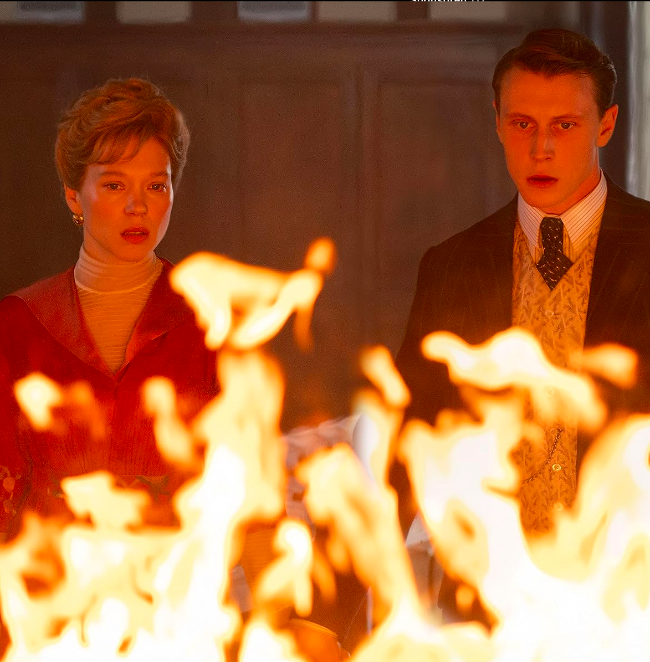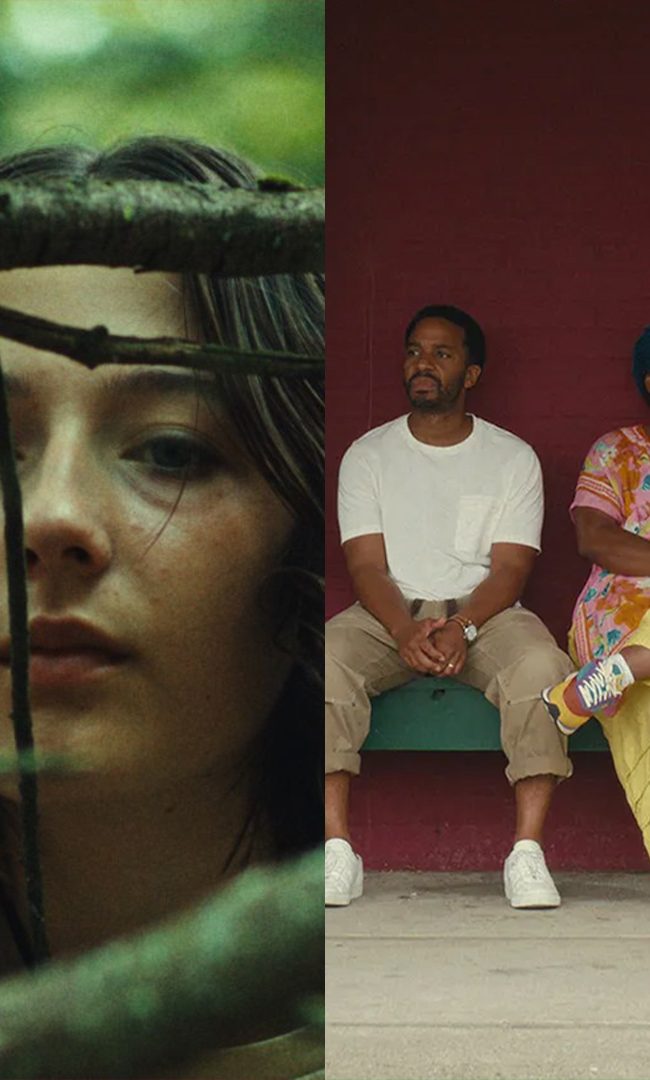A Conversation With Pablo Aravena (NEXT: A PRIMER ON URBAN PAINTING)
(Note: In light of the film’s domestic DVD release, we are posting a re-edited version of an interview HTN contributor Pamela Cohn conducted with filmmaker Pablo Aravena in 2006 and first posted at her blog Still In Motion.)
Five years in the making, first-time director Pablo Aravena’s NEXT: A Primer on Urban Painting, made its US premiere at the 2006 AFI Film Festival. As part of the International Documentary Competition, this ambitious, free-wheeling film rockets the audience around the globe, talking to the pioneers and artists behind the graffiti/street art movement such as Lee Quionones, Heavyweight, Delta, Banksy, Kami and Sasu, Os Gerneos and Swoon, as they describe what it means to create graffiti.
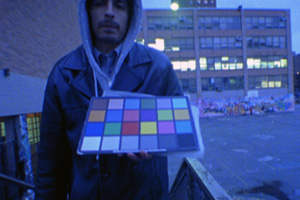 Hammer to Nail: Tell me about your background. Was film something you always thought of pursuing?
Hammer to Nail: Tell me about your background. Was film something you always thought of pursuing?
Pablo Aravena: I’m originally from Santiago de Chile. I grew up there until I was twelve years old and then my parents decided to emigrate to Canada. It was the Pinochet dictatorship at the time so it was kind of rough. We moved to Toronto and I did high school there and then I moved to Montreal for university. I went to Concordia University for film school. Basically, I guess I’m a North American Chilean, a guy with multiple identities and I speak a few languages now. I guess I consider myself a citizen of the world.
In terms of what drew me to film, you know Chile is a country of authors. I kind of had this dream of writing books. I like the idea of the public intellectual, a strong point of view, talking about the society of which you’re a part, its problems. It’s a very Latin American model. You have [Mario] Vargas Llosa and [Gabriel Garcia] Marquez; I really admire those guys. I read a lot of books. I was working in a movie theatre, a part-time job when I was in high school. I started as a candy boy and then became an usher at the Cineplex Odeon in Toronto—that’s the theatre that does the Toronto International Film Festival every year and I worked for four or five years so I got to meet a lot of directors and see films outside the big Hollywood ones.
I realized, too, that it was a job—they didn’t just get made by themselves. It was telling stories, which is what I ultimately wanted to do. It’s where I got inspired to be a filmmaker. Also, I always grew up with film. I have my own Cinema Paradiso story. When I was a little kid growing up by the beach in Chile, we had this theatre and you paid a quarter and got to watch three movies. We’d watch a [Pier Paolo] Pasolini back to back with Porky’s back to back with some Chuck Norris movie, so I always watched a lot of films. I guess it was something I fell into because I had a love for it by watching tons of movies.
H2N: What kinds of influences did you have growing up?
PA: In film school, obviously I educated myself and kind of gravitated towards filmmakers like Scorsese or Godard, Wong Kar-Wai later, documentarians like [Patricio] Guzman or Fernando Solanas. Basically, I chose the courses that I liked and I wrote about the directors that I liked and the ones who influenced my style, like Mike Leigh, guys like that. I guess the people who put the characters and the drama first and films that have a social edge to them—that’s always been important to me. I grew up being concerned about social and political issues, north/south issues, as well. Having grown up in South America and then moving to North America, I kind of have a foot in both worlds and I think I can communicate both those realities.
The other major influence was growing up with hip-hop culture. It’s part of what gave me my identity as an immigrant. I really wanted to talk about all those things—hip-hop culture, urban culture, multi-cultural free space, this DIY way of creating your own culture. I identified with all these people dealing with marginalized realities and could identify with that. This is what I want to talk about in my work.
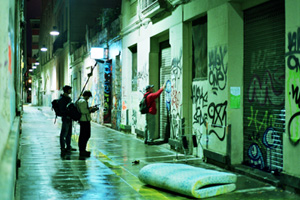 H2N: Did you plan for your first film to be a documentary project? Tell me about the genesis of this film—why a doc instead of a feature?
H2N: Did you plan for your first film to be a documentary project? Tell me about the genesis of this film—why a doc instead of a feature?
PA: I’m actually a fiction guy. I didn’t really study documentary in school. I watched a few here and there. I was trying to do some narrative stuff. I wrote a script about graffiti. It became a bit of an obsession and it was something with which I was well versed… Growing up with hip-hop, I was more into the music, but with the graffiti, that kind of got in my head and I met some artists too that I became friends with and ended up hanging out with them. Initially, I was going to make a film on them and the burgeoning graffiti scene. This was in the late ‘90s, this whole kind of renaissance was just starting. Then I started seeing some more and doing research and then the light bulb for the film came to me. Let’s show it as a world culture. I’d heard and seen stuff in magazines from France, Japan, from Germany. I thought to myself, “Wow, I want to see how this culture, especially on the visual side, has been adapted from what came out of New York and how they’ve made it their own.” That was the starting point.
From there, I made a list of cities that I wanted to catalogue for the film because of the work. It wasn’t just the worldwide thing, but also the evolution of the form… The work I’m talking about specifically transcended the tagging [initials, a name, an alias that is an artist’s “street” signature]… That’s where the concept of NEXT came from, you know, how this art had evolved and become more sophisticated. It’s 40 years old now so it’s evolved, it changes, it mutates and it grows up.
That’s what I wanted to show in the film—to legitimize and show a regular audience, not just the graffiti kids, that it is a serious art form, it’s the art of now. This form will be recognized in 50 years, the abstract expressionism of the turn of the 21st century, and it really reflects the times… because we’re living in the age of hyper-capitalism. These artists use the art form where strategies of corporations are emulated in terms of creating logos, branding. Except in branding themselves as artists, they’re kind of subverting that language.
If you look at the people that are doing it, it’s really the first generation that’s grown up with mass media so it’s natural that they’re going to express themselves in that way. I think it’s also a continuation of those ideas generated from Pop Art in the ’70s and ’80s. It’s really a combination of all that. I’ve become very passionate about it in the process of making the film and I really want to push the art form and show people. Again, it’s a way of legitimizing this urban culture. So many times it gets denigrated. I see similarities to the period in the ‘50s with the Beatniks and the jazz musicians, it’s the same thing for me. I think it will be remembered. I wanted to really capture the moment. Imagine hanging out with the expressionists at the cafes. I’m getting them when they’re young and really just beginning to develop their craft and their style.
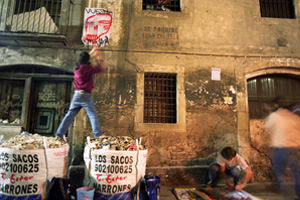 H2N: Where did you get funding for this? Was it self-funded for a while as you gathered your footage and just started shooting in the hopes that money to finish it would come through? Was there a formal fund raising plan, a budget?
H2N: Where did you get funding for this? Was it self-funded for a while as you gathered your footage and just started shooting in the hopes that money to finish it would come through? Was there a formal fund raising plan, a budget?
PA: Basically, I just started shooting, a combination of DVcam, Super-16, some 35mm, it’s really like a collage. It was a film about art so I wanted to play with textures. I’d seen Julien Donkey-Boy and loved his [director, Harmony Korine’s] whole use of video texture because, you know, in the last year, video has really come to the forefront. When it first came out, people would complain or get snooty about it, “Well, it’s not film.” My response is that I’m not trying to make it look like film. I like the fact that it’s got this pixel texture, let’s use it for that. It’s a new medium, like switching from oils to acrylic, paintings with texture—35 grain, cut with a video grain, cut with a Super-8 grain, it’s going to give it a certain feeling.
But yeah, the hardest thing was getting the money. In Canada, we have arts funding, Telefilm, a lot of provincial institutions, but part of it was that I had some Canadian content, but it wasn’t all Canadian, so I had issues with that. The other thing was that they just didn’t get it. Graffiti? Vandalism? Art for kids? I had the luck of getting some grants from the Quebec Arts Council. That was my seed money. For the first three shoots, I borrowed equipment, I got tickets using air miles. The first shoot I shot, the second shoot, I got a cameraman, the third shoot, a sound guy came on board. I always wanted to do it at a high level, but I also just really wanted to get the ball rolling.
Once that happened, I cut a demo out of the first three shoots and that’s how I got the grant money. I didn’t want to wait—this stuff was timely, coming to the forefront, really blowing up and I didn’t want to miss the moment and I had the access. Basically, with that seed money, I got some more grants from other agencies, an inter-cultural agency out of Quebec that would give me plane tickets, the crew worked for very little pay, sometimes just a per diem or for the experience, guys I went to school with so I had relationships there. We were all coming up, all trying to make our names as DPs, sound men, editors, directors, so it was a nice energy.
I met Agnes B. [French clothing designer and patroness of the arts] on my third shoot. I interviewed her for the film, as a matter of fact. She never made it to the final cut but her company was really interested in the concept of the film and so we stayed in touch. I sent them the demo and they helped me with a little bit of money to go shoot in London. Then, I got the grant money from Quebec Arts Council and went to Brazil, and when I got yet another grant, I used that money to go to Europe. One of the stops in Europe was Paris and that’s when I really got it locked down with her and she jumped on board as a co-producer. Once she came on board, I was really able to finish the vision that I had because I really wanted to get the worldwide thing. Brazil is a third-world country, Japan is an Asian country, and then the major cities in Western Europe and North America—that’s what I wanted to do, that was in my vision. I had chosen those cities because of their trajectory in graffiti, their history and also the artists doing work in those places. So, with her support, I was able to finish the shoots. (Japan was a very expensive place to shoot!) And do all the post—and do everything at a decent level. I wanted to really make a film that was professional because I wanted to get it into the top festivals, sell it, get it out there. I had these amazing artists giving me their time and I wanted to represent that at a high level, not a handi-cam, kind of dirty video. I was very happy that that was the way it worked and the freedom Agnes B.’s support gave me.
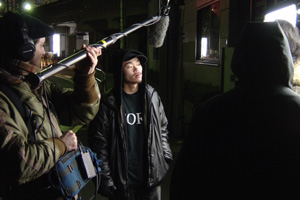 H2N: Did you have any idea when you started that it would take you five years?
H2N: Did you have any idea when you started that it would take you five years?
PA: Yeah, it took a while but I was kind of possessed. I like to say it was my personal jihad. I was working in the industry for six years, assistant this, assistant that, editor, AD, it was great experience, you know? But I kind of reached that point where I said to myself, “I better make a film now, because that’s why I got into this line of work in the first place, or I better change career paths.” I wanted to express something. And I knew that I had a project that was different about an art movement that was blowing up…
I was very passionate and adamant about it. It was very handmade. I just didn’t want to let it go until I completed the vision. I didn’t realize it would take me five years, I thought it would be two or three, but in the end I was happy that it took that long because I was really able to think it through and let this idea sink in and, you know, it was a process film. I learned a lot about what it was while I was making it and talking to different people.
I think that adds something to the project because the culture itself is still very much a street culture, it’s not so much in the world of academe just yet. There are some books, there are some academics talking about it, but it’s not really accessible to the average person. I wanted to keep that flavor in the film so it was an interesting process for me, the whole learning as I went—there was always a certain freshness, a feeling of discovery. The film is a travelogue, my travelogue, and the audience can hopefully experience my enthusiasm and everything I discovered about it when I was seeing it and shooting it for the first time.
H2N: What’s the biggest lesson you learned as a filmmaker?
PA: Producing. Out of necessity, of course. But now, I like to do it! I enjoy it. I enjoy all the schmoozing and hustling for money. I’m not intimidated at all by all these situations I run into. Even at first, I’d felt like I’d been doing it for a while. I didn’t feel out of my element at all. I like the control, too. I like to make the calls, take care of the money-end, being involved in the sales, all that stuff. It’s my baby, you know? For the kinds of films I want to make, you know I look to the guys like Jim Jarmusch or John Sayles—they always have a foot in the producing end and that’s why they always make the movies they want to make.
H2N: What do you have in mind for your next film project?
PA: I’ve got a couple of ideas. I want to do some music docs, maybe something on broken beat, a new genre of music coming out of West London and going all over now and again, it’s kind of working with people that I know. I met some of these DJ producers in Puerto Rico not too long ago and we want to do an exchange because they saw the film. I really believe the art form replicates the music. I want to try and do that in film.
There’s another project I want to develop in Brazil, a socially relevant fiction idea that talks about kids painting on the streets. I really want to do a narrative project. I’m trying to be pragmatic too. I think this music doc I could probably get off the ground and get some money to shoot it faster. The fiction thing I want to develop and do that relatively quickly, as well—go for an indie, low-budget shoot. I really want to put the value and the time into the script. I’m thinking of a neo-realist approach in terms of mixing actors and real people, really working with the community there. My mission is to go to Sao Paulo in the next six months and get working on that. It will probably be a co-production with France, Canada, maybe the States and Brazil, get a little piece of the pie from each place, get a decent first-time feature director budget with the subject matter and method of shooting I want to do. A decent budget; it doesn’t have to be huge. I want to keep some freedom, some liberty, too. Someone gives you a lot of money, they start telling you what to do.
I believe the artist should profit and should own the work. I don’t believe in the model of the starving artist. The second thing is that, you know, I like the control. If I put a little money on the table, that gives me something to say when it’s time to make some hard decisions or have control over final cut. I was spoiled with this film and I don’t want to go back. And I like doing it. I think there is a creative side to producing. I discovered that I have a good business and entrepreneurial mind and I enjoy that.
H2N: What kind of advice would you give a first-time filmmaker?
PA: Find something that you’re passionate about and go for it. There are no excuses anymore—with DV cam or with HD. If you’re a guy that’s even semi-serious, you’re going to know somebody with a camera and you’re going to have a friend or two or a network of people willing to come work on your film for, like, a pair of sneakers or something, whatever you got. Not to sound like Nike, but just do it, carpe diem, just go for it. That’s how it starts and it snowballs from there. I never imagined that I would learn so much but it’s only because I took that first step. Part of the reason why I didn’t make anything before was because I guess I was just paralyzed, intimidated—it’s so big, it’s so much, the thought of making a film. I definitely won’t experience that again, though, that’s for sure.
— Pamela Cohn








